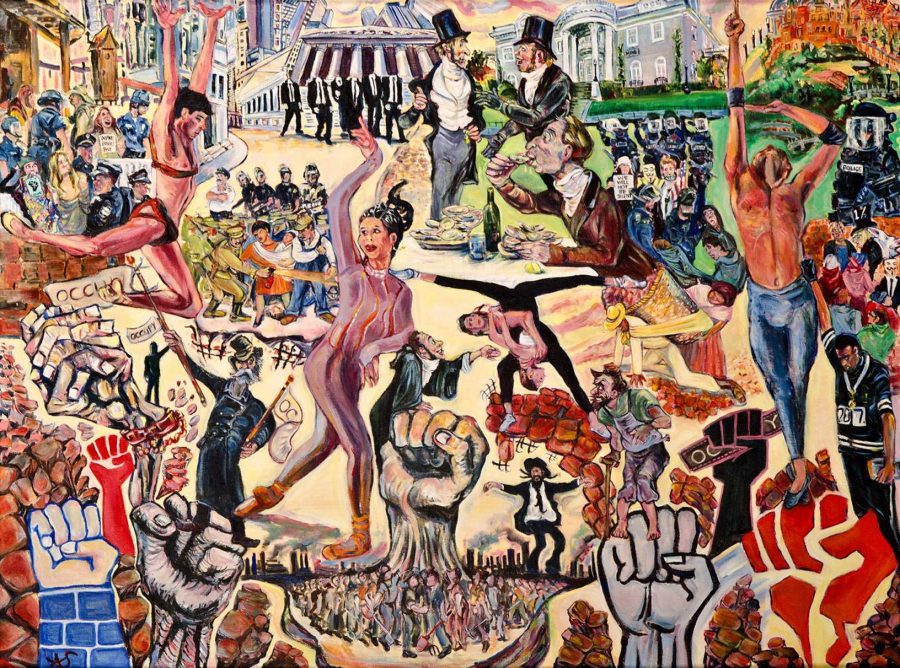The word “artist” includes dancers, actors, musicians, sculptors, painters and more. Should these people, when given the public platform to do so, be permitted to share their personal beliefs — political, social and religious? This is a difficult question, especially when looking at what Americans are currently facing in our country. Interviews with two Salt Lake-based artists reveal fascinating perspectives on the relationship between art and politics.
Linda C. Smith, Executive and Artistic Director of Repertory Dance Theatre, has been working with RDT for 53 years. Whitney Tassie is currently a Senior Curator and Curator of Modern and Contemporary Art at the Utah Museum of Fine Arts. Both women discussed how their institutions create an artistic platform. In her long tenure at RDT, Smith has pondered how, and if, art and politics can be combined. She ultimately concluded that “all art is political.” Art creates a platform for creators to demonstrate their beliefs, mixed with artistic passion. Tassie said, “[As artists, we] encourage thinking, creating a place for social justice, whatever your definition may be.” The museum, dance pieces and any other type of artwork that you can think of can be used as spaces where comfortable and safe conversations can occur.
This “[raising of] a dialogue,” an idea that Smith used to explain the thinking of RDT, was an idea used to think about more controversial works. We want to “open up idea[s], but not by shutting people down.” Tassie added that we just want to “get people thinking.” Nothing is more boring in the world than people not evaluating what is put in front of them. We, humans, are discerning, and mixing politics with art forces us to use this skill, which is too often unpracticed. Many artists, as mentioned by Smith, “bring their own integrity and are sensitive to where they are.” That being said, entering an art exhibit or performance requires open-minded thought. “We aren’t trying to come at you with a “big stick”, though some may,” Smith explained. “We merely want to encourage people to think.”
I feel for those who want to be able to enter a theater or museum and step out of reality. Those artistic experiences without a political agenda are relaxing for many people. This raises questions about the role of politics in art. Meeting politics in art can be difficult for those entering museums and theaters expecting to find entertainment or a thrilling experience. We must remember, as art enthusiasts, that we have the chance to make a difference. Ignoring reality can ruin our chance to change.
Tassie emphasized that the “importance of art history,” is something being heavily implemented in museums, especially the UMFA, in order to force people to look at the reality of life. For example, the UMFA chose an exhibit by a Japanese man who was placed in a Utah internment camp in the middle of his artistic career during World War II. The stories we can learn from the way his artwork changes throughout life forces us to enter art with an open mind and heart. It persuades us to face reality. RDT currently has a piece inspired by the Bear’s Ears National Monument here in Utah. Instead of entering their creative process with a political agenda, they merely entered it looking at the land. After their process, the outcome was not necessarily biased or opinionated, but rather a piece giving thanks to the Earth we have. While this may not be a major political issue that many look at, an artist has the resources and tools to enter their process with an open mind, choose a thought and add it to a conversation. Smith stated it well when she said it is the “artist’s utmost responsibility” to create the dialogue, and Tassie added that “we owe it to our history and what has happened” to be honest, yet open for conversation.
Smith compares this action of arts in politics as being “a mirror for society.” These artistic outlets create a “mirror” for what is happening, has happened or has the potential to happen. She noted how artists “have a wonderful opportunity [to be]…mirrors to society…[and] we mustn’t shy away” from our reality. So, arts and politics go together hand in hand, whether you agree with it or not. Much of art’s purpose is to allow space for reflection. Art is deep and will take you along with it if you let it. How you choose to interpret it is all up to you.




Kimkeehyon • Mar 2, 2020 at 5:02 am
I sympathized a lot with your art and politics.
In which country art is politics. Politics is art. Art is politics..
I will read your article often and sympathize with it.
A Korean man who loves art sends it to you.
Thanks